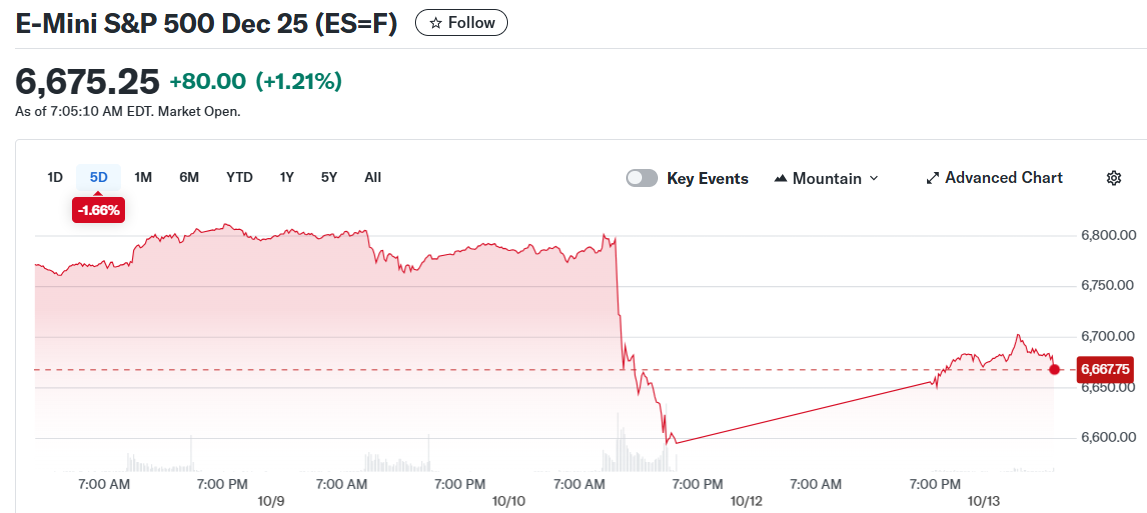TLDR
- Dow futures climbed 437 points (1%) while S&P 500 and Nasdaq 100 futures rose 1.3% and 1.9% respectively on Monday morning
- Trump posted “Don’t worry about China, it will all be fine” on Sunday after Friday’s tariff threats erased $2 trillion in market value
- President threatened 100% additional tariffs on Chinese goods starting November 1 in response to China’s rare earth export restrictions
- Government shutdown reached day 13, delaying consumer inflation report from Wednesday to October 24 and other key economic data
- Major banks report earnings this week with JPMorgan, Goldman Sachs, Wells Fargo, and Citigroup releasing results Tuesday
U.S. stock futures bounced back Monday morning after President Donald Trump walked back his aggressive stance on China trade. Markets prepared to recover from Friday’s steep losses that wiped out $2 trillion in value.

Dow Jones Industrial Average futures rose 437 points or 1% in pre-market trading. S&P 500 futures advanced 1.3% while tech-heavy Nasdaq 100 futures climbed 1.9%.
The rally followed Trump’s social media post Sunday evening attempting to calm worried investors. The president wrote on Truth Social that China trade tensions “will all be fine.”
Trump described Chinese President Xi Jinping as “highly respected” and said he “just had a bad moment.” The comments marked a sharp change from Friday’s threats.
On Friday, Trump announced plans to impose an additional 100% tariff on Chinese imports starting November 1. The threat came after China moved to restrict rare earth mineral exports.
The Friday announcement triggered panic selling across Wall Street. All three major indexes posted their worst day since April as investors fled to safety.
Trump later told reporters the November 1 tariff deadline remains active. However, he suggested the U.S. and China have time to reach an agreement before then.
The president’s strategy appears to maintain pressure on Beijing while preventing further market decline. China reported September export growth exceeded expectations as it expanded trade with other nations.
Government Shutdown Delays Key Data
The federal government shutdown entered its second full week on Monday. The ongoing funding dispute has disrupted the release of important economic reports.
Officials postponed the consumer inflation report from its Wednesday release date to October 24. Retail sales data, wholesale inflation figures, and other reports face similar delays.
The data blackout creates uncertainty for investors and Federal Reserve policymakers. If Congress doesn’t resolve the shutdown by Friday, Fed officials enter their pre-meeting blackout period without critical information.
Fed Chair Jerome Powell speaks Tuesday about economic outlook and monetary policy. His comments take on added importance given the lack of fresh data.
Bank Earnings Launch Reporting Season
Wall Street’s largest banks kick off third-quarter earnings season this week. JPMorgan Chase, Goldman Sachs, Wells Fargo, and Citigroup report Tuesday.
Bank of America and Morgan Stanley release results Wednesday. Analysts project 6% profit growth across the six major banks compared to last year’s third quarter.
United Airlines and Taiwan Semiconductor Manufacturing also report earnings this week. The results arrive as markets process trade tensions and data delays.
Treasury yields moved lower with the 10-year note falling 11 basis points to 4.04%. Gold futures surged 2.3% to reach $4,093 per ounce, marking another record high.
The dollar edged up 0.1% against major currencies. Stock futures pointed to a strong open as investors responded to Trump’s softer tone on China trade relations.


